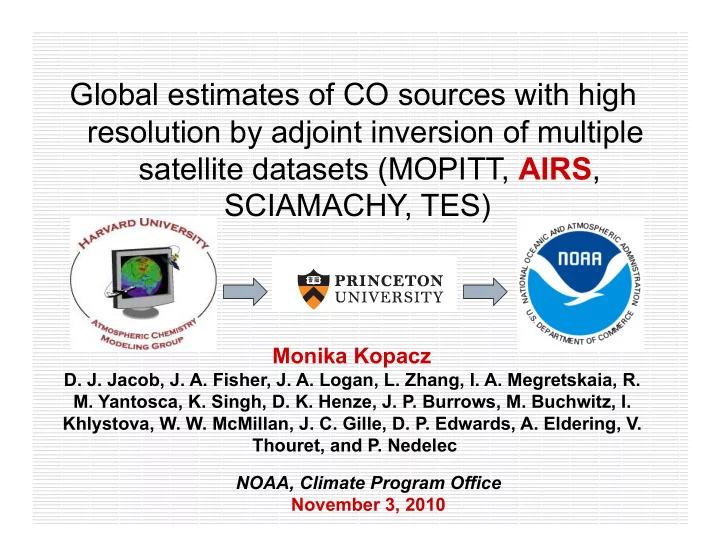

Global estimates of CO sources with high resolution by adjoint inversion of multiple satellite datasets (MOPITT, AIRS , SCIAMACHY, TES) Monika Kopacz D. J. Jacob, J. A. Fisher, J. A. Logan, L. Zhang, I. A. Megretskaia, R. M. Yantosca, K. Singh, D. K. Henze, J. P. Burrows, M. Buchwitz, I. Khlystova, W. W. McMillan, J. C. Gille, D. P. Edwards, A. Eldering, V. Thouret, and P. Nedelec NOAA, Climate Program Office November 3, 2010
Satellite data available for constraining CO sources Annual mean May 2004- April 2005 CO columns expected to be different due to different vertical sensitivity, but are they consistent?
Data consistency: Chemical Transport Model (CTM) as a comparison platform satellite 1 satellite 2 satellite 3 SATELLITE DATA global Chemical Transport Model (CTM) forward model in situ observations TRUTH but very sparse in time and space
GEOS-Chem Chemical Transport Model (CTM): the comparison platform CTM EMISSIONS CONCENTRATIONS Compare with in situ data Compare with satellite data surface aircraft Northern midlatitudes (Ireland) MOPITT CO columns model data M O G Z Northern tropics (Hawaii) M A GEOS-Chem+ MOPITT AK D I C Vienna
Model: satellite correlations May 2004 – April 2005 global daytime columns (averaged on Measure of information content: degrees of 2°x2.5° resolution of freedom (DOFs) color dimension GEOS-Chem) *TES data for 2005-2006 Unit: 10 18 molec/cm 2 Kopacz et al . 2010
Inverse estimates of CO sources satellite CO column: y GEOS-Chem CO column: F(x a ) ≠ 0 0.88 1.75 2.62 10 18 molec/cm 2 3.50 a priori sources: x a + ε a satellite data (MOPITT, AIRS, SCIAMACHY Bremen) : y + ε o model concentrations: F(x) + ε m observation error: ε e = ε o + ε m + ε r min RESULT : monthly CO source estimates at 4º x 5º resolution
A priori emissions ( x a ): fossil fuel, biofuel and biomass burning 3 1 4 2 Regional inventories: Global inventories: 1. US fossil fuel: NEI99 – 60% Fossil fuel EDGAR 3.2 (global) 2. Mexico fossil fuel: BRAVO Biomass burning GFED2 3. Europe fossil fuel: EMEP (global) 4. Asia fossil fuel: Streets et al. 2006 for China and Streets et al. 2003 elsewhere
A posteriori estimates of CO sources: emissions too low Annual mean a posteriori/a priori emission ratio prior too high prior too low Annual total: 1350 Tg
Seasonal variability of emissions: largely missing in a priori estimates * * Streets et al. [2006] did not include Includes regional inhomogeneity Streets et al. [2003] seasonality
Regional CO source estimates: N. America Previous study Current study w/ 60% correction spring (MAM) winter (DJF) > GEOS-Chem w/ NEI99 INTEX-A emission inventory observations summer (JJA) fall (SON) Hudman et al. [2008] NEI99 60% too high (in the summer) Conclusion: Hudman et al. [2007] correction to NEI99 inventory ok in the summer, not in fall-winter Emissions too high Emissions too low
Regional CO source estimates: Europe Findings: Similar seasonality and spatial inhomogeneity as in N. America Possible reasons for underestimate: residential heating, “cold starts”
Regional CO source estimates: Asia Findings: Stronger seasonality in China than in N. America, no considerable seasonality in India Possible reasons for underestimate: residential heating, “cold starts”
Improvement in model-data agreement from source inversion Fractional model bias: (model-data)/data during sample period: Sept-Oct-Nov 2004 Conclusion: a balance of information, but AIRS dominates due to data density AND regional instrument inconsistencies
Comparison with independent surface measurements (GMD network) Northern Hemisphere : Southern Hemisphere : great improvement still a challenge to match obs. Model a posteriori Model a priori Obs (2004-2005) Obs (climatology)
Comparison with independent aircraft measurements (MOZAIC) Model a priori Model a posteriori Obs (climatology)
Major conclusions 1. GEOS-Chem CTM is a useful intercomparison platform for analyzing satellite data consistency 2. MOPITT, AIRS, TES and SCIAMACHY CO concentrations are generally consistent, especially in the northern hemisphere 3. Global annual CO emissions are found to be 1350 Tg 4. CO emissions in N. America, Europe and China exhibit strong seasonality, consistent with surface and aircraft observations 5. Tropical (mostly biomass burning) sources in S. America and Africa are estimated to be 183 and 343 Tg, mostly driven by AIRS data (larger than MOPITT or SCIAMACHY in southern hemisphere) 6. Regional satellite inconsistencies in southern hemisphere result in overestimated sources motivation for more accurate data
Acknowledgement: Funding provided by NASA graduate fellowship THANK YOU!!!
Amount of 4 r 2 = 0.65 r 2 = 0.73 GEOS-Chem CTM a priori slope 0.76 slope 0.71 information in 3 model-satellite correlations 2 Measure of MOPITT AIRS information content: 0.5 1.0 1.5 1 0.5 1.0 1.5 degrees of freedom 4 (DOFs) r 2 = 0.85 r 2 = 0.63 GEOS-Chem CTM 0 slope 0.89 slope 0.70 3 Note: DOFs not available for 2 SCIA; TES w/ reprocessing with TES MOPITT a priori MOPITT a priori does not change 0.5 1.0 1.5 0.5 1.0 1.5 1 SCIA correlations 0 1 2 3 4 0 1 2 3 4
Recommend
More recommend